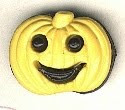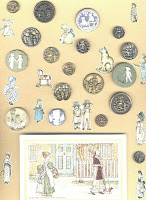

The first picture is a button and a piece of pyrite, they are from a button collection I acquired years old. The collector had the 2 on a small card and had written MARCASITE and on the back of the card she wrote "Iron pyrite mineral from which marcasites were faceted. Never rusts and has a yellow hue with age."
Looking closely at the button, it is brass with RIVETED cut steels not marcasites (see number 5 below)
The other picture is a brooch pin with 4 marcasites.
The below information is from Jocelyn Howells newest book..thank you Jocelyn for letting me use it.
-----------------------------------------------------------
MARCASITE was first used in the 18th C. to imitate diamonds
1. Trade name for pyrite, an iron mineral with brilliant luster.
2. Does not respond to a magnet nor does it rust, as do cut steels.
3. Pyrite crystals lend themselves to cutting and faceting and were used to decorate jewelry as well as buttons.
4. The visual difference between marcasite and cut steel can be characterized as: "Cut steel shines, but marcasite SPARKLES."
5. Marcasite was always set in metal, usually silver, sometimes pewter, and not riveted as cut steel was.
6. It was used with jewels (or glass) and set in "cups" to form designs, very rarely set with prongs.
7. BUTTONS EMBELLISHED WITH MARCASITE ARE RARE
Jocelyn Howells latest book (published in 2006) "BUTTON MATERIALS A-Z: Identification Guide" can be purchased from her site at
http://mysite.verizon.net/buttonjoss/
copy and paste the link or
CLICK on Button Book
Button Book
I love this book..if you are a button collector this is a wonderful MUST HAVE BOOK, Peg
















































